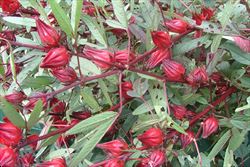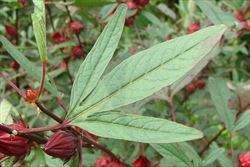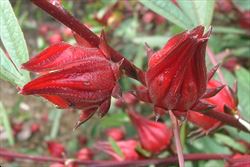Click on images to enlarge

habit in fruit (Photo: Sheldon Navie)

stems, leaves and fruit (Photo: Sheldon Navie)

close-up of three-lobed leaf (Photo: Sheldon Navie)

close-up of flower (Photo: Sheldon Navie)

close-up of fruit covered with enlarged fleshy red sepals (Photo: Sheldon Navie)
Scientific Name
Hibiscus sabdariffa L.
Family
Malvaceae
Common Names
Florida cranberry, Indian sorrel, Jamaica sorrel, Jamaican sorrel, Java jute, red sorrel, rosella, roselle, rozelle, sorrel, wild rosella
Origin
The exact origin of this long-cultivated species is obscure, however it probably originated in tropical Africa.
Naturalised Distribution
Widely naturalised in northern Australia (i.e. in northern Queensland, the northern parts of the Northern Territory and northern Western Australia). Also recently recorded as naturalised in south-eastern Queensland.
Notes
Rosella (Hibiscus sabdariffa) is regarded as an environmental weed in Western Australia and the Northern Territory. It has escaped cultivation and is now a weed of watercourses, creekbanks, riparian areas, spinifex grasslands and savannas in the monsoonal dry tropics of northern Australia.
In Western Australia, rosella (Hibiscus sabdariffa) has invaded disturbed and undisturbed natural vegetation in the Kimberley region. Because of this, it has been listed as a moderately important species in the Environmental Weed Strategy of Western Australia. It also competes with native species in riparian habitats and eucalypt savannas in the northern parts of the Northern Territory. Rosella (Hibiscus sabdariffa) has invaded conservation areas in this region (e.g. Howard Springs Nature Park) and is listed as a medium priority weed species on Aboriginal lands in the Northern Land Council area.

